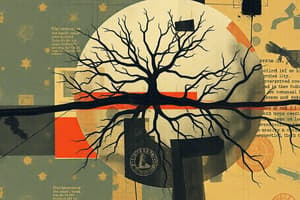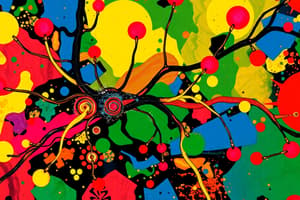Podcast
Questions and Answers
Which of the following is the primary neurotransmitter in the cholinergic system?
Which of the following is the primary neurotransmitter in the cholinergic system?
- Acetylcholine (correct)
- Serotonin
- Dopamine
- Noradrenaline
Where is acetylcholine primarily synthesized?
Where is acetylcholine primarily synthesized?
- Histidine and serotonin
- Choline and active acetate (correct)
- Glutamate and GABA
- Tyrosine and DOPA
What enzyme is responsible for breaking down acetylcholine?
What enzyme is responsible for breaking down acetylcholine?
- Dopamine beta-hydroxylase
- MAO
- Choline esterase (correct)
- COMT
Which sites release noradrenaline?
Which sites release noradrenaline?
Which of the following best describes cholinergic receptors?
Which of the following best describes cholinergic receptors?
Which type of receptor is stimulated by muscarine?
Which type of receptor is stimulated by muscarine?
What is a known effect of nicotinic receptor activation?
What is a known effect of nicotinic receptor activation?
What distinguishes alpha 1 receptors from beta 1 receptors?
What distinguishes alpha 1 receptors from beta 1 receptors?
Which drug category can increase the actions of the parasympathetic nervous system?
Which drug category can increase the actions of the parasympathetic nervous system?
What is the primary neurotransmitter acting on muscarinic receptors?
What is the primary neurotransmitter acting on muscarinic receptors?
Flashcards are hidden until you start studying
Study Notes
Chemical Transmission
- Acetylcholine (ACH)
- Found in all preganglionic neurons, all autonomic ganglia, and parasympathetic postganglionic neurons
- Also found in sympathetic postganglionic neurons to sweat glands and vasodilators of blood vessels in skeletal muscles, adrenal medulla, and the neuromuscular junction
- Synthesised from choline and active acetate using choline acetyl transferase
- Broken down by the enzyme choline esterase into acetic acid and choline
- Destroyed faster than noradrenaline
Noradrenaline (Norepinephrine)
- Present in granulated vesicles of nerve terminals in most sympathetic postganglionic endings and some brain neurons
- Synthesised from tyrosine through a series of enzymatic steps:
- Tyrosine hydroxylase converts tyrosine to DOPA
- DOPA decarboxylase converts DOPA to dopamine
- Dopamine is converted to noradrenaline in granulated vesicles
- Inactivated by:
- Active neuronal reuptake
- Monoamine oxidase (MAO) enzyme
- Catechol-O-methyl transferase (COMT) enzyme
Autonomic Receptors
- Found on the cell membrane of effector organs
- Affected by the combination with chemicals or drugs
- Classified into two main groups:
- Cholinergic receptors
- Adrenergic receptors
Cholinergic Receptors
- Stimulated by acetylcholine
- Classified into two types:
- Muscarinic Receptors
- Stimulated by muscarine
- Nicotinic Receptors
- Stimulated by nicotine
- Muscarinic Receptors
Actions of Acetylcholine (Cholinergic Actions)
- Muscarinic Actions (Parasympathetic)
- Cardiac inhibition and decrease in heart rate
- Pupillary constriction and accommodation
- Stimulation of salivary secretion
- Stimulation of gastrointestinal secretion and motility
- Contraction of the urinary bladder and rectum
- Bronchoconstriction
- Nicotinic Actions
- Stimulation of autonomic ganglia
- Stimulation of the adrenal medulla to secrete adrenaline and noradrenaline
- Stimulation of the neuromuscular junction, causing skeletal muscle contraction
Adrenergic Receptors
- Stimulated by catecholamines (epinephrine and norepinephrine)
- Classified into two types:
- Alpha (α) Receptors
- Stimulated mainly by noradrenaline
- Blocked by phentolamine
- Subtypes: α1 and α2
- α1 receptors have excitatory actions
- α2 receptors have inhibitory actions
- Beta (β) Receptors
- Stimulated mainly by adrenaline
- Blocked by propranolol
- Subtypes: β1 and β2
- β1 receptors have excitatory actions
- β2 receptors have inhibitory actions
- Alpha (α) Receptors
Actions of Adrenergic Receptors
- α Receptors
- On smooth muscle: mostly excitatory, causing contraction
- On blood vessels: vasoconstriction
- On sphincters: contraction of sphincters in the gastrointestinal tract, bladder, and rectum
- β Receptors
- On smooth muscle: mostly inhibitory, causing relaxation
- On blood vessels: vasodilation
- On sphincters: relaxation of sphincters
Drugs That Modify the Actions of the Parasympathetic NS
- Drugs that can increase or decrease the actions of the parasympathetic nervous system
- Classified into two groups:
- Parasympathomimetic drugs
- Induce effects similar to acetylcholine (or increase its actions)
- Also called choline agonists
- Include:
- Drugs stimulating cholinergic receptors
- Muscarinic agonists: e.g., muscarinic
- Nicotinic agonists: e.g., nicotine in small doses
- Drugs inhibiting the choline esterase enzyme
- Reversible choline esterase inhibitors: temporary action, e.g., eserine and prostigmine.
- Irreversible choline esterase inhibitors: permanent action, e.g., parathion
- Drugs stimulating cholinergic receptors
- Parasympatholytic drugs
- Block the effects of acetylcholine (or decrease its actions)
- Include:
- Muscarinic blockers: e.g., atropine, used as pupil dilator, spasmolytic, and to decrease bronchial secretions
- Nicotinic blockers: e.g., nicotine in large doses, used as ganglionic blockers, hexamethonium
- Neuromuscular blockers: e.g., curare
- Parasympathomimetic drugs
Drugs That Modify the Actions of the Sympathetic NS
- Drugs that can increase or decrease the actions of the sympathetic nervous system
- Classified into two groups:
- Sympathomimetic drugs
- Induce effects similar to catecholamines (or increase its actions)
- Include:
- Drugs stimulating the ganglia: e.g., nicotine in small doses
- Drugs increasing the release of NE from nerve endings: e.g., amphetamine
- Drugs stimulating adrenergic receptors: e.g.,
- α agonists: noradrenaline
- β agonists: adrenaline
- Sympatholytic drugs
- Block the effects of catecholamines (or decrease their actions)
- Include:
- Drugs blocking the ganglia: e.g., nicotine in large doses
- Drugs decreasing the release of NE from nerve endings: e.g., reserpine
- Drugs blocking adrenergic receptors: e.g.,
- α blockers: phentolaimine
- β blockers: propranolol
- Sympathomimetic drugs
Studying That Suits You
Use AI to generate personalized quizzes and flashcards to suit your learning preferences.




